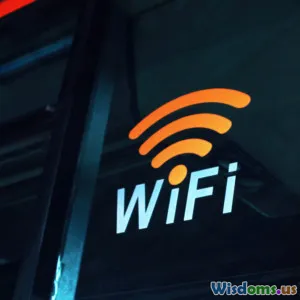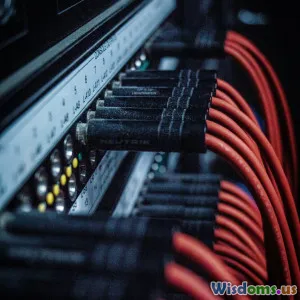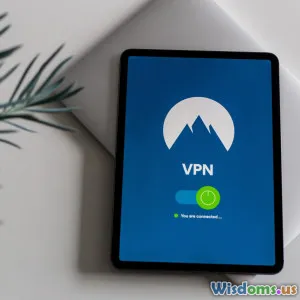
Is 5G Safer Than Public WiFi for Your Data
9 min read Exploring the data safety differences between 5G networks and public WiFi hotspots, uncovering risks and protection strategies. (0 Reviews)
Is 5G Safer Than Public WiFi for Your Data?
In our hyper-connected world, staying online is as critical as powering on the lights. Two major options for access—5G cellular networks and public WiFi—offer distinct advantages, but they also raise pressing questions about privacy and data security. Given that cyber threats are increasingly sophisticated, it’s vital to understand which connection type better safeguards your information.
This article embarks on an in-depth exploration of 5G and public WiFi in terms of data safety, dissecting how each technology handles your personal and professional information, and helping you make informed decisions about how you connect.
Understanding the Basics: What Are 5G and Public WiFi?
Before diving into comparative safety, let’s clarify what these technologies entail.
What is 5G?
5G, or fifth-generation cellular technology, is the latest evolution in mobile networks. Designed for higher speeds, lower latency, and enhanced reliability, 5G aims to support everything from streaming high-definition video to powering the Internet of Things (IoT) with lightning quick responsiveness.
Unlike previous generations, 5G uses a combination of low, mid, and high-frequency bands, including millimeter waves, to expand bandwidth and improve data transfer rates. Major telecom providers around the globe have been aggressively rolling out 5G infrastructure since 2019.
What is Public WiFi?
Public WiFi refers to internet access points set up in communal venues such as cafes, airports, hotels, and shopping malls. These networks are typically free or low-cost and rely on wireless routers connected to wired or cellular internet backbones.
Public WiFi networks often lack strict security controls, making them notorious for enabling man-in-the-middle attacks, eavesdropping, and unauthorized access. It's estimated that over 40% of consumers connect regularly to public WiFi,[^1] feeding into potential exposure risks.
[^1]: Cybersecurity Ventures Report, 2023
Assessing the Security Architecture
The foundation of safety lies in the design architectures of 5G and public WiFi.
Encryption Protocols Involved
5G Encryption: 5G networks employ robust encryption standards like 256-bit Advanced Encryption Standard (AES) and 128-bit subscriber identity protection protocols. The network architecture includes mutual authentication between the device and network operator — a leap forward compared to 4G. The introduction of new security features such as Unified Authentication Framework (UAF) greatly reduces the chance of rogue base stations or network spoofing.
Public WiFi Encryption: Most public WiFi hotspots use Wi-Fi Protected Access II (WPA2) or sometimes the upgraded WPA3. Unfortunately, many public networks leave encryption disabled or set it to open access for convenience, which exposes users to heightened security risks like traffic interception.
Authentication and Access Control
5G demands authentication from devices before granting network access. Technologies like SIM-based authentication ensure only legitimate devices can connect. Conversely, public WiFi often employs minimal authentication—simply accepting terms and conditions can get you online, which makes unauthorized connections and fake access points easier for hackers to create.
Network Segmentation and Monitoring
To deter attacks, 5G networks utilize superior network segmentation, isolating user data and employing real-time anomaly detection systems across multiple operators. Public WiFi generally lacks advanced network monitoring and segmentation, making widespread attacks like session hijacking more feasible.
Common Threats Encountered
Public WiFi Risks
- Man-in-the-Middle Attacks: Hackers intercept data exchanged between you and the router, often without your knowledge.
- Evil Twin Hotspots: Fake WiFi access points mimic legitimate hotspots to lure victims.
- Unencrypted Traffic: Exposure of sensitive activities like password entry.
- Malware Injection: Vulnerable devices on open networks become targets.
5G Threat Landscape
- Signaling System Attacks: New vulnerabilities in signaling protocols can disrupt communications or conduct certain eavesdropping.
- Rogue Base Stations (Stingray Attacks): These fake cell towers trick devices into connecting.
- Supply Chain Risks: Because 5G depends on widespread infrastructure and equipment, backdoors or compromised hardware can pose risks.
However, due to the stronger encryption and authentication mechanisms, successful exploitation on 5G for mass user data interception is significantly harder compared to the average public WiFi access point.
Real-World Case Studies and Statistics
In 2021, researchers uncovered over 2,000 malicious WiFi hotspots in major cities globally, with many masquerading as trusted venues like airports and cafes.[^2] Victims reported data theft involving banking credentials and personal emails. The FBI has continually issued warnings about public WiFi threats, urging caution.
Meanwhile, despite some early concerns about 5G security, US government agencies, including the Cybersecurity and Infrastructure Security Agency (CISA), in 2023 stated that large-scale interception of 5G communications is currently low risk due to strong cryptography and oversight.[^3]
[^2]: Journal of Cybersecurity, 2021 [^3]: CISA Advisory Bulletin, 2023
User Behavior and Protective Measures
Even the safest network on paper can be compromised by poor user practices.
How to Protect Data on Public WiFi
- Use Virtual Private Networks (VPNs) to encrypt your traffic end-to-end.
- Avoid accessing sensitive services such as online banking or shopping.
- Ensure websites use HTTPS.
- Disable automatic connectivity features.
Enhancing 5G Security
- Keep device firmware and OS updated to patch vulnerabilities.
- Leverage two-factor authentication on accounts.
- Use SIM-lock or device encryption methods.
Future Trends in Wireless Security
5G is not the final frontier; research into 6G and post-quantum cryptography aims to further harden wireless communication.
On the public WiFi front, some venues are deploying next-gen WiFi 6 and WPA3 encryption to restore trust. However, user education remains paramount.
Conclusion: Which Is Safer?
When comparing data safety, 5G networks currently offer a considerably more secure environment compared to public WiFi� largely due to advanced encryption, rigorous authentication, and active monitoring. Public WiFi remains a hotspot for cyberattacks due to lax security and open access policies.
That said, no network is completely invulnerable. Users must practice cautious online behavior and apply protective tools like VPNs and updated security software regardless of network choice.
Takeaway
To safeguard your sensitive data, favor 5G over public WiFi when possible. If you need to use public WiFi, always use a VPN, stick to secure websites, and avoid crossing critical information.
Ultimately, understanding the inherent risks and adopting diligent security measures will empower you to navigate the digital world with greater confidence and safety.
Stay informed, stay protected.
References
- Internet Society: Security in 5G Networks (2022)
- FBI Public Service Announcements on WiFi Safety (2023)
- Cybersecurity & Infrastructure Security Agency Reports (2023)
- Journal of Cybersecurity Research (2021)
Rate the Post
User Reviews
Popular Posts

















